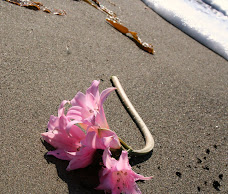 Wounded Knee Creek
Wounded Knee CreekIn the frozen waste of the Badlands I sigh
under the snow for those who fell here
I remember the red-stained white snow
churned into mud and blood by fear
I hold in my white arms the memory
of frightened people running like deer
Between my banks the water still flows
to honor them, tear by helpless tear
(© Chris Alba)
On Dec. 29, 1890, along Wounded Knee creek in South Dakota, 146 Sioux people were massacred by the U.S. Army. Nearly half of them were women and children. They were retreating as ordered to the Pine Ridge reservation.
Surrounded by a force of more than 350 men armed with cannon and guns, the Sioux had given up what rifles they had and were powwowing with cavalry leaders about the ordered retreat. Their old chief, Big Foot, was bleeding from pneumonia.
The phenomenon known as the Ghost Dance had recently led to a resurgence of resistance by the native tribes to the reservations demanded by the U.S. government. The Ghost Dance vision foresaw the return of the buffalo, and a new freedom for the Indian. Officials feared it would lead to native uprisings against whites.

U.S. government Indian police killed Sioux holy man Sitting Bull on Dec. 15. Chief Big Foot led the surviving members of the tribe toward the Pine Ridge reservation as commanded.
During the powwow, a single gunshot was heard. Immediately the cavalry, including mounted guns, erupted into gunfire at point-blank range. Half of the Sioux people were killed outright, along with 25 soldiers from “friendly fire.” Many of the remaining Sioux were tracked and killed. A few survived to make the trip to Pine Ridge.
The U.S. government awarded 20 Medals of Honor to the Army 7th Cavalry.
The photos here, from top to bottom are: Sioux Chief Big Foot, dead at Wounded Knee (from the National Archives); chief Sitting Bull, killed two weeks earlier in Standing Rock; and burial of the dead at Wounded Knee (from the Library of Congress).
With special thanks to Mark Durfee of The Walking Man (see my blog roll), you’ll find an awesome ballad of the massacre at Wounded Knee here: The Ghost Dance by Robbie Robertson
The saga of Wounded Knee didn’t end in 1890.
By February 1973, corruption within the Bureau of Indian Affairs and the Tribal Council was at an all-time high. Tension on the Pine Ridge Indian reservation was building and quickly getting out of control.

Elders of the Lakota Nation (known as the Sioux) asked for assistance from the American Indian Movement (AIM), an activist group of mixed tribes. This brought to a head more than a hundred years of racial tension and appalling treatment by the U.S. government.
On that winter day in 1973, a large group of armed Native Americans reclaimed the village of Wounded Knee in the name of the Lakota Nation. They were quickly surrounded by U.S. Marshals and military troops with automatic weapons, who cut off roads and food supplies to the town.
The siege lasted 71 days. It ended in an armed battle with U.S. forces. Two AIM members died by gunfire. One U.S. Marshal was paralyzed.
I sat in the audience as AIM member Dennis Banks spoke at my university a few years later. I’ve never forgotten the experience.
The massacre at Wounded Knee was the end of the Indians' free reign in this country. The siege of Wounded Knee was the beginning of a new Indian groundswell for freedom from the reins of government control
There’s a very fine book about the westward expansion of the U.S and its destruction of the Native American people, called Bury My Heart at Wounded Knee, by Dee Brown. It culminates with the massacre at Wounded Knee, which is generally considered to be the end of the Indian Wars. You can find Wikipedia’s discussion of it HERE.





20 comments:
a sad day in history...tear by helpless tear...
13 years prior to the massacre at wounded Knee three company's of the 7th Cavalry met their fate at the Little Big Horn. For well over a hundred years after wards the ego driven Custer was held as a hero to American school children.
The related history by the White soldiers who actually participated at Wounded Knee was that there was a single Aboriginal who still had a rifle. some say he was deaf.
A soldier moved to disarm him and grabbed the barrel of the rifle and it discharged killing the soldier.
This was the story given to justify the murder of the aboriginal women and children.
Personally I believe that the 7th cavalry was going to ride in and massacre the native peoples regardless of any movement towards the reservation or not because they had to claim their vengeance for Custers idiocy and his violation of direct orders to NOT attack at Little Big horn.
Sitting Bull beginning in 1874/5 had been sending emissaries out to all of the native tribes who until that time had mainly warred against each other; making unions and treaties because of the encroachment on the lands granted the natives by a lying federal government.
(the federal government was more concerned with the Civil War than the natives until about 1870)
What Sitting Bull had done was pulled together the largest conference of chiefs and warriors ever known in 1876. Some say as many as 10,000 native peoples were on hand in the area of little Big Horn. Little Big horn was only one of two battles that the natives fought and beat the US Cavalry.
Of course passions run deep and the US Cavalry with the full backing of the government was on a mission of genocide from 1876 forward.
The battles though cooled now still in my belief have at least one other victim living in this present day and that is Leonard Peltier. Who has been incarcerated since 1977 for the murder of two FBI agents.
http://en.wikipedia.org/wiki/Leonard_Peltier
His trial like all dealings with the Federal Government and Native Americans was riddled with holes. The two others who were with him at the time were acquitted in Federal Court by reason of self defense. When Peltier who had run to Canada was finally extradited, like wounded Knee the government who had lost the conviction of the other two was going to do whatever necessary to reclaim their supremacy.
It is well past time to either retry or free Peltier. And to never forget what the European Americans have done to the lands and peoples of the aboriginal stock.
May God bless the souls of all those who fought for freedom. You clearly have great knowledge of this segment of history and have left me wanting to know more. Thanks for the book referral. Sending peaceful wishes for you today!
Thank you to The Walking Man for his input here, clarifying the context of the massacre and adding information to expand the story.
Please do check the Wikipedia file on Leonard Peltier. It is absolutely worth knowing more about his situation.
Thank you for posting this! My grandmother is Native American, and I've often heard her sigh, "how quickly people forget."
This was a travesty. As was most of our dealings with the Aboriginal Americans even back to the time of Columbus who enslaved them and made them search for gold when there was none to be found. Ignorance is no excuse. Not then not now.
Very painfully horriffic.
Your poem however, is honorable and haiku-like
and spoken by the earth, in a sad mother's voice.
tears in the water, white arms, snow churned (foam-like) brings so many unspoken images, I had to read it again and again.
Keep it coming.
Wonderful post. The history of the U.S. government's dealing with native peoples is filled with disgraceful betrayals and set-ups, but the powerful have and will always take what they can from the less powerful or powerless, and it is never gentle or pretty, but it is sometimes inevitable.
Just to say...while he was certainly flawed, Custer was not an idiot. It's far too easy to paint one party or the other as all good or all bad. The truth, as usual, lies somewhere in between.
Man's inhumanity never ceases to horrify me. Your poem-tribute is beautiful, and thanks to you and Mark for the history -- lest we believe the revisions and lest we forget.
Fireblossom...History has shown exactly who George A. Custer was. A man driven towards power, who wanted to make a name for himself with designs on the presidency. He resented the fact that after the war his rank was reduced to Lieutenant Colonel because there were simply too many generals. He wrote as much in his letters to his wife.
He defied a clear and direct order by his commanders when he attacked at Little Big Horn. He had been told to specifically not move in if he encountered hostiles. Yet seeing only roughly 40 Natives he divided his force into three columns and sent them in a classic pincer movement with every intention of wiping them out. Those are the historical records.
Had he not been killed there was every real chance he would have faced a court martial for his defiance. Custer by all written accounts left from the men who served with and under him was not a good commander. He was always at war with not only his enemies but his superiors as well, ever willing to un-necessarily risk the lives of his men and himself for fame which he intended, with his wife's full complicity, to power him to his long term goals.
Being "brave" in the face of gunfire does not mark a wise man only one who hasn't the sense to fight from cover.
Something else was in the American consciousness at the time of the so-called Indian wars: The U.S. claimed the divine right to expand from sea to shining sea through the concept of Manifest Destiny.
That was the notion that the "settlement" of this country was inexorable and inevitable, as well as divinely ordained.
"Savages" were depicted as obstacles to the rightful possession of the land.
The great westward expansion was the focus of the nation in the post Civil War era; it was the good, right, and God-driven thing to do.
With all the religious fervor of the Manifest Destiny, the country and its eastern residents rode roughshod over the original people without consideration of human rights. That is a little odd considering that the civil rights of black people were considered during the slavery issue in the Civil War.
The 50 united states of America are the living fruits of that destiny. I want to remember, though, those less-powerful people who suffered and died in the process, like the Indians, the blacks, the Asians. It's meaningful to me to keep a sense of the price paid by those who were victims of the process. Thank you all for entering the discussion.
What a lovely tribute. I really loved your poem, also. I am old enough to remember the 1973 uprising. Robbie Robertson has an entire CD dedicated to the American Indian, and some of the people who are still imprisoned because of the 1973 uprising. I have a copy somewhere, I think it is a bootleg, but there are some awesome songs on there. The last photo was very disturbing to me, reminded me of the holocaust during WWII.
This week end there was a news story about a cemetary that is being moved to make way for a strip mall or office building or whatever. There was a huge outcry, and the families were on TV, all indignant. I understand their point of view, but before I even read this post I was thinking to myself of all the malls built on top of dead Native Americans and no one thinks anything about that.
I agree with Fireblossom, whoever is in power writes "history."
Power is still carried today. I may not like how it's displayed but I can be assured that God has his hand in it all. Let my powerful contribution be loving at it's core and only of God's Will always!!
I'm just glad I'm expected to amend only what I have personally done wrong, not to spend my time editing what fathers and forefathers 'may have' contributed in error. I just don't know that much about my family history.
I'm sad that people were and are still harmed in wars, in the name of progress, in lies and in truth. I cannot say with any conviction that I have heard of or experienced anyone who has a monopoly on mis-treatment, pain or difficulty at the hands of others. I just can't. I stop researching and start to build defenses long before the absolute truth is found.
Righteous indignation is deadly. I'm trying to learn how to alleviate it in me.
Your poem, as I read it, feels haunting and wrought with emotions.
The photo of the dead is horrible to see. I too wonder at what we do to each other--the large massacres and the much smaller day to day inhumanities. There are too many. I am sure that God wept over this. We all should weep over this.
very interesting thanks for sharing this I'm glad I stopped here today. I loved your poem Chris.
Walk In My shoes
" a People's History" by Howard Zinn is also a phenomenal look at American's truest history and not the one that we were taught...
This post and a couple of others really do show us that we can and are capable of such heinous acts while also possesing the grace of great acts of love...lets hope that as we move forward that love shows and shines like you dear Chris...
Love
Gabi
Thanks, Chris...beautiful poem. Guess I'd better step on over to Walking Man's too....
Thought provoking comments...
The past is the past.
If there is any thing that is true is that one can not change history no matter how regrettable it may be.
The reason we need to dig and dig and dig until we have a clear picture of not only the statistical information but the honest how and why of certain events is so that we as individuals will be able to recognize present injustice and if not fearful, stand as one against them.
Much like the brave souls of Iran right now that are standing in the face of a well armed cavalry and continuing to voice their opposition to a heinous wrong being perpetrated upon them.
Ignorance of FACTUAL history is certain repetition of its worst events.
Dee Brown's book is excellent. What happened at Wounded Knee was terrible, a very sad day in history. You may know the Buffy Ste Marie song Bury My Heart at Wounded Knee, also covered by the Indigo Girls, powerful song.
Post a Comment